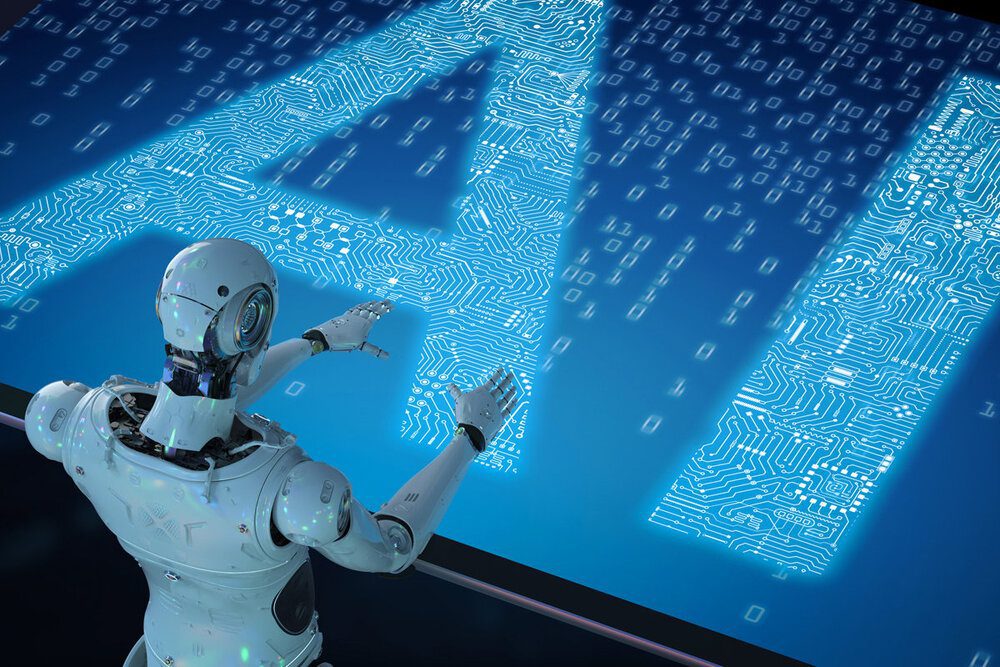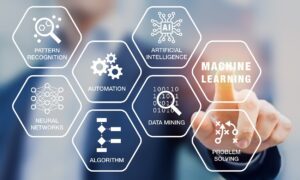Many applications that artificial intelligence adds to our lives!
You must have heard the name artificial intelligence by now. Contrary to what the movies show, artificial intelligence is not a robot that seeks to conquer the world; In fact, artificial intelligence is not a new topic and has been present in our daily life in various forms for decades. Perhaps at first glance, it is hard to believe that an advanced technology such as artificial intelligence has such normal applications in everyday life, but the fact is that this technology is already used in many popular devices and software. In the following article, we will look at the examples of the application of artificial intelligence in everyday life, and we will also examine the industries that have used the benefits of artificial intelligence to increase the efficiency, accuracy and productivity of their operations.
Routers can be considered one of the first and oldest artificial intelligence applications. For years, GPS software such as Waze and Google Maps have been trying to suggest the best possible route to users by using artificial intelligence and considering factors such as traffic, construction and weather. These softwares use a process called routing, which involves finding the shortest path between two points. Artificial intelligence has increased the efficiency and accuracy of this process so that software can update the route in real time and suggest alternative routes.
Routing software
Other capabilities such as destination prediction also allow these software to learn the traffic pattern of users and predict it before entering the destination. Google’s Live View can be seen as a clear example of the use of artificial intelligence in navigation. This new feature relies on artificial intelligence and augmented reality (AR) to provide directions at each intersection directly on the smartphone camera to make navigation easier, especially in unfamiliar environments.
Shared travel software
The emergence of routing software has led to the emergence of a completely new industry that we know today as shared travel. Thanks to the GPS capabilities of these software, ordinary people can use their car without any previous training or experience to take others to their destination. In recent years, the popularity of shared travel software, such as Uber and Lyft, has increased, and artificial intelligence has played an undeniable role in this success. This technology has made the whole shared travel experience easy and possible with its many features, including the automatic matching of passengers and drivers.
Shared travel software
Another application of artificial intelligence in shared travel software is to improve security. For example, Uber has developed a feature called RideCheck that uses data from sensors and GPS to detect unusual cases such as long-term stops or deviations from the route. If something happens, both drivers and passengers will be notified and can contact the Uber Security Center. Machine learning also helps increase the accuracy of ETAs and detects fraud and abuse. With the development of shared travel software, we should expect the increase of artificial intelligence-based capabilities that will improve the safety, comfort and enjoyment of the travel experience.
Short videos and video summarization
Several years ago, a software called Vine appeared on the market that published short videos; But in the end, it was abandoned for not being innovative. Now popular platforms such as Tik Tok, YouTube’s short video section, Instagram Rails and Snapchat are in the center of attention. Short videos are not a new topic, but what gives them a new look is their artificial intelligence capabilities. Powerful machine learning algorithms personalize content on these platforms to make sure users see what they like and want.
Of course, the work of artificial intelligence does not end here. Deep learning technology can summarize videos so that users can see more content. This feature is especially suitable for people who like to follow the news of the day, but do not have time to watch entire videos. Google’s Video A.I is capable of identifying more than 20,000 locations, objects and activities, and thus, can provide accurate descriptions of videos. Facebook and YouTube have also used artificial intelligence to automatically generate subtitles for their videos. These subtitles, which cover more than 70 languages, are one of the important capabilities of artificial intelligence.
Video games
The most exciting and transformative examples of artificial intelligence are seen in video games. Artificial intelligence-based software can produce realistic graphics and make interactions between game characters believable; This will revolutionize the video game industry. One of the most impressive examples of the use of artificial intelligence in video games can be seen in the 2020 version of Cyberpunk 2077. This game created realistic characters by relying on the artificial intelligence system called Digital Human Engine (or superhumans). This system analyzes a large amount of data, including more than 100 types of facial muscle movements, so that the digital characters it creates are indistinguishable from real people.
Video games
Of course, role-playing games such as Cyberpunk 2077 are not the only ones that have benefited from artificial intelligence capabilities. Games like Call of Duty and Halo also use artificial intelligence to make the characters in front of the user smarter and more challenging. Games like Call of Duty and Halo also use artificial intelligence to make the characters in front of the user smarter and more challenging. The characters in front of the user can hide or actively try to defeat him by using combat techniques. Artificial intelligence has also helped make player movements more realistic in sports games. In addition to the big game studios, other companies are also using AI capabilities to improve their games.
3D photography
3D photography is a branch of art whose popularity is slowly increasing. 3D photos, unlike normal photos, give the viewer a sense of depth to feel that he is personally in that environment. This technology takes one or more two-dimensional photos and adds a third dimension to them; This process is done using special equipment or by post-processing the image with artificial intelligence software. Artificial intelligence plays an important role in recording and processing 3D photography. For example, Google’s Pixel 4a has a dual-camera setup that allows the user to take 3D photos without the need for any additional equipment.
The post-processing process is even more interesting. At this stage, artificial intelligence automatically creates 3D models from 2D images. Without the use of artificial intelligence, such a process would take a lot of time and require a lot of expertise. Currently, there are companies such as Nvidia that provide these services. These companies use NerRF, or Neural Radiation Fields, to create 3D models and achieve extraordinary results. You may have seen various types of artificial intelligence in product advertisement images that display the desired product from different angles by rotating the computer mouse. 3D photography is still in its early stages, but with the help of artificial intelligence, it will soon demonstrate its ability to transform interaction with online images.
Face Recognition
The facial recognition industry has been in the spotlight and controversial recently, as it raises many privacy concerns. However, one cannot deny the accuracy and increasing application of this technology. Facial recognition technology uses artificial intelligence to recognize people based on their physical characteristics. This technology can be used in various fields, including security and mass surveillance, authentication and even marketing.
One of the most common uses of facial recognition is in social networking platforms. For example, Facebook uses this technology to suggest users who to tag in their photos. This technology is also used to unlock the phone screen and many mobile phones have this feature. Law enforcement agencies use facial recognition to identify criminals and missing persons. This technology is by no means flawless, but it is improving. Companies like Clearview AI provide facial recognition software to government agencies like the FBI and ICE.
At first glance, these services seem good and useful; But the reality is that in order to provide such services, Clearview collects the data of millions of people without their consent. Such an issue raises many concerns about privacy and misuse of technology. The company was recently forced to pay a fine of €3.7 million and must delete all UK data.
Smart assistants
Smart assistants are becoming more and more popular. Amazon Alexa and Google Assistant are used all over the world. These assistants use artificial intelligence to do things like set phone alarms, play music, and write shopping lists, and the technology is constantly evolving. For example, Alexa can now understand users’ natural language and give them the appropriate response. Such a feature takes speech recognition technology one step further, as instead of giving commands, users can simply speak to their assistant.
Such capability is realized thanks to neural networks that support digital assistants. These networks are continuously learning and gaining a better understanding of the complexities of human language and speech. Although smart assistants are still at the forefront, their potential is not hidden from anyone. These assistants have gone beyond basic tasks and can now manage all aspects of the home, including security and heating systems.
Spam email filter
Another old example of the use of artificial intelligence in everyday life can be considered as a spam email filter. This feature uses artificial intelligence to identify and block spam emails. Most email providers use some form of spam filtering to reduce the volume of unwanted emails.
For example, Gmail uses machine learning to detect spam emails. The company’s artificial intelligence analyzes features such as the sender, content and links in the email, and then based on this information, decides whether the email is spam or not. Since this system has access to a lot of data, it has been very successful so far.
Suggest content
Artificial intelligence is also used to suggest content to users. Based on this technology, Netflix and Amazon can recommend new movies to their users based on their history. Spotify also uses artificial intelligence to recommend new music tracks to listeners. The company’s AI-based algorithms analyze the songs a user has listened to, the artists they follow, the genres they like, and even their location to personalize their recommendations.
These suggestions are based on machine learning technology that uses user data to improve its performance. In other words, the more users listen to Spotify, the more accurate the recommendations they receive. This type of content suggestion will improve in line with the progress of artificial intelligence. In the future, we will see more advanced and personalized recommender systems that adapt to mood and time.
Online banking
Financial technology or fintech is one of the fields of artificial intelligence that has a bright future ahead. Online banking can be seen as a prime example of fintech, which uses artificial intelligence to make banking operations simpler and friendlier. For example, financial institutions use advanced chatbots to help answer customer questions. Based on natural language processing (NLP) technology, these chatbots understand customer questions and provide relevant answers.
AI-powered chatbots are available 24/7 and can handle a large volume of inquiries at any given moment. Unlike customer service employees, chatbots don’t get bored and don’t make mistakes. Another example of the use of artificial intelligence in online banking is fraud detection. Banks use machine learning to detect suspicious activity, such as unusual withdrawal patterns or account withdrawals in unusual locations. Credit and lending decisions have also been automated by relying on artificial intelligence. Banks can make more informed lending and interest rate decisions by automatically analyzing customers’ financial history, credit score and other data.
Self-driving cars
Tesla’s self-driving cars have been in the headlines recently, but Tesla is not the only company active in this field. Today, most car manufacturers are investing in autonomous vehicles (AV). The goal of these technologies is to build self-driving cars that can drive themselves by relying on a combination of sensors, cameras, and artificial intelligence. The strengths of such cars are quite clear; Self-driving cars reduce the number of accidents and the need for parking spaces. Traffic becomes lighter because cars can communicate with each other and optimize their routes.
However, the road to the realization of self-driving cars is also facing challenges. For example, the technology must be able to handle all weather conditions and route types. In addition, self-driving cars must be resistant to hacking to avoid being targeted by cyber attacks. These flaws are visible in Tesla cars, but since the company pioneered the AV industry, it has not received much blame. However, other companies active in this industry should pay attention to these points.
households
Earlier, we mentioned the use of smart assistants to manage home security systems, but artificial intelligence can also be used to increase comfort and convenience at home. For example, Roomba is a robotic vacuum cleaner that automatically cleans the floor. Using sensors, Roomba detects dust and debris and then adapts its cleaning pattern. The garbage bag of this robotic vacuum cleaner is automatically emptied.
households
In general, the law of working with artificial intelligence is very simple: If there’s something you don’t want to do yourself, there’s probably a machine that will do it for you. Among the home devices based on artificial intelligence that have been made to date, the following can be mentioned:
Self-cleaning cat toilet
Robotic lawn mowers
Automatic feeding devices for pets
Automatic sprinkler system
Clothes folding machines
Extensive security and monitoring
Artificial intelligence can be used to enhance security and widespread surveillance. For example, cameras equipped with artificial intelligence are able to detect suspicious activities, such as people walking around the premises or strange movements of cars. Low-quality CCTV images can also be improved by relying on artificial intelligence so that people’s faces and car license plates can be recognized. Machine learning improves the quality of images and makes existing colors more distinct. The Google Home system can also seamlessly integrate most of the systems used in homes.
In the field of national security, artificial intelligence monitors social networks to identify signs of radical ideas and terrorist acts. AI’s ability to analyze large volumes of data allows the technology to identify patterns that humans cannot. Law enforcement can rely on this information to target problematic user accounts. In this way, accidents such as school shootings or other terrorist attacks are prevented. In addition, with the help of artificial intelligence, it is possible to detect illegal drones and nearby missiles. The United States Army is working on building an artificial intelligence that can detect and track the target in real time and at any time of the day or night.
E-commerce and online shopping
Artificial intelligence helps the user experience in online shopping. This technology can be used to recommend products, personalize search engine results, and provide customer service. For example, Amazon uses artificial intelligence to recommend the right products to its customers based on previous purchases and search history. In this way, customers have a better experience and Amazon increases its purchases.
E-commerce and online shopping
However, the most prominent benefits of AI in e-commerce belong to back-end operations. For example, businesses can use AI to predict demand, optimize inventory, and predict pricing trends. This technology allows companies to avoid buying too much or too little. The use of artificial intelligence in advertising campaigns is also significant, because it can recognize the most popular searched words or determine the best area to place ads.
Conclusion
According to what has been said, it can be claimed that artificial intelligence has played a role in our lives for years, but in recent times its presence has become stronger. In the not-so-distant future, we will see more examples of artificial intelligence applications in our daily lives. It is true that one cannot deny the existing concerns about the security issues of this technology, but most of these problems are caused by humans themselves. The benefits of general AI outweigh its potential risks; So we can use this technology to improve comfort, security and efficiency in our lives.
Source: Hoshio








